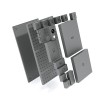Project Ara: A Modular Smartphone Using Electro-Permanent Magnets
One of the hot topics this week is Project Ara. It is a modular smartphone that can be customized and updated using electro-permanent magnets!
If you haven’t heard about the project yet, it could entirely change the way we update our smartphones. Instead of buying a phone every few years, Project Ara phone’s modular units allow owners to replace and upgrade parts as needed. The smartphone fosters user customization and could possibly reduce the estimated 20 to 50 million tons of environmental e-waste generated each year.
How It Works
It’s not surprising that the technology behind the modular smartphone is pretty impressive. To hold the various parts in place, Project Ara’s developers use electro-permanent magnets. They then use an electrical current and magnetism to attach and release upon user command. As the name implies, an electro-permanent magnet is a hybrid cross between a permanent magnet and an electromagnet. Electro-permanent magnets have electromagnetic properties because they are programmable and can be switched on and off. They also have permanent magnet properties because they do not require a power source to attract. Furthermore, the Project Ara consists of many companies including, Google, 3D Systems Corp, and Phonebloks. They are all working together to create this new mobile technology. Phonebloks technology is the inspiration behind the project while 3D Systems Corp is using its 3D printing technologies to manufacture the physical, interchangeable modules to fit the smartphones.Technology Outlook
It isn’t certain yet whether or not these new magnetic, modular smartphone technologies will be a hit with consumers but we're excited to follow its development in the next several months.Some are anticipating an unveiling of a working prototype this month and a possible launch in 2015. To learn more about Project Ara, you can see the latest sneak peek video of its development at Google here.
What This Discovery Means and More with Apex Magnets
We are constantly on the lookout for new magnet discoveries. For more updates on electro-permanent magnets, browse our neodymium magnet information and magnet facts sections of the blog, or subscribe to our newsletter today.Photo source: Dave Hakkens

